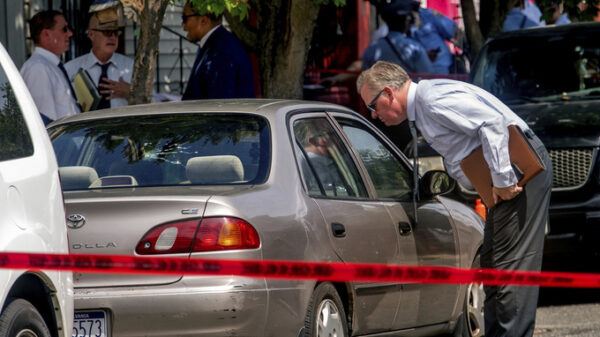FILE – Michael Carneal, 27, is escorted by a guard from the U.S. District Courthouse in Paducah, Ky., March 18, 2011. Carneal pleaded guilty in 1998 to killing three students and injuring five others in 1997 at Heath High School, when he was 14. In the quarter century that has passed, school shootings have become a depressingly regular occurrence in the U.S. Carneal’s parole hearing in September 2022 raises questions about the appropriate punishment for children who commit heinous crimes. Even if they can be rehabilitated, many wonder if it is fair to the victims for them to be released. (Stephen Lance Dennee/The Paducah Sun via AP, File)
When 14-year-old Michael Carneal opened fire on his fellow students during a before-school prayer meeting in 1997, school shootings were not yet a part of the national consciousness. The carnage that left three students dead and five more injured at Heath High School, near Paducah, Kentucky, ended when Carneal put down his weapon and the principal walked him to the school office — a scene that seems unimaginable today.
Also stretching today’s imagination — Carneal’s life sentence guaranteed an opportunity for parole after 25 years, the maximum sentence permissible at the time given his age.
A quarter century later, Carneal is 39 with a parole hearing next week that comes at a very different time in American life — after Sandy Hook, after Uvalde. Today police officers and metal detectors are an accepted presence in many schools, and even kindergartners are drilled to prepare for active shooters.
“Twenty-five years seemed like so long, so far away,” Missy Jenkins Smith recalls thinking at the time of the sentencing. Jenkins Smith was 15 when she was shot by Carneal, someone she considered a friend. The bullet left her paralyzed, and she uses a wheelchair to get around. Over the years, she has counted down the time until Carneal would be eligible for parole.
“I would think, ‘It’s been 10 years. How many more years?’ At the 20-year anniversary memorial, I thought, ‘It’s coming up.’”
Ron Avi Astor, a professor of social welfare and education at the University of California, Los Angeles, who has studied school violence, said public opinion around school shootings and juvenile punishment has changed a lot over the last 25 years. In the 1980s and 1990s, Astor provided therapy to children who had committed very serious crimes, including murder, but were rehabilitated and not jailed.
“Today all of them would have been locked up,” he said. “But the majority went on to do good things.”
Jenkins Smith knows first-hand that troubled children can be helped. She worked for years as a counselor for at-risk youth, where her wheelchair served as a stark visual reminder of what violence can do, she said.
“Kids who would threaten school shootings, terroristic threatening, were sent to me,” she said. Some are now adults. “It’s great to see what they’ve accomplished and how they’ve changed their lives around. They’ve learned from their bad decisions.”
But that doesn’t mean she thinks Carneal should be set free. For one thing, she worries that he is not equipped to handle life outside of prison and could still harm others. She also doesn’t think it would be right for him to walk free when the people he injured are still suffering.
“For him to have a chance at 39. People get married at 39. They have children,” she said. “It’s not right for him to possibly have a normal life that those three girls he killed will never have.”
Killed in the shooting were 14-year-old Nicole Hadley, 17-year-old Jessica James, and 15-year-old Kayce Steger.
Astor said that when it comes to the worst crimes, like many people, he struggles with the question of what age children should be held strictly accountable for their actions. As a class exercise, he has his students consider the appropriate punishment for a perpetrator at different ages. Should a 16-year-old be treated the same as a 12-year-old? Should a 12-year-old be treated the same as a 40-year-old?
Without any national consensus, you end up with a patchwork of laws and policies that sometimes result in very different punishments for nearly identical crimes, he said.
The shooting at Heath High School took place on Dec. 1, 1997, the Monday after Thanksgiving break. Less than four months later, 11-year-old Andrew Golden and 13-year-old Mitchell Johnson shot and killed four classmates and a teacher at Westside Middle School near Jonesboro, Arkansas. They wounded another nine children and one adult. The pair were tried as juveniles and released on their 21st birthdays.
Two decades later, in 2018, 19-year-old Nikolas Cruz killed 17 students and staff members at Marjory Stoneman Douglas High School in Parkland, Florida. At the same time Carneal is being considered for possible release, a Florida juryis decidingwhether to sentence Cruz to death.
Jenkins Smith has tried for years to understand why Carneal opened fire on his fellow students that day. She was in the marching band with Carneal, and, before the shooting, “I loved being around him because he made a boring day fun,” she said.
She met with Carneal in prison in 2007 and had a long conversation with him. He apologized to her, and she said she has forgiven him.
“A lot of people think that exonerates him from consequences, but I don’t think so,” she said.
Carneal’s parole hearing is scheduled to start on Monday with testimony from those injured in the shooting and close relatives of those who were killed. Jenkins Smith said she knows of only one victim who supports some form of supervised release for Carneal — less confining than prison but not unrestricted freedom. On Tuesday, Carneal will make his case from the Kentucky State Reformatory in La Grange. If the board rules against release, they can decide how long Carneal should wait before his next opportunity for parole.
The parole hearing will be conducted by videoconference, but Jenkins Smith said she will position her camera to show her full body so the parole board can see her wheelchair. It will be, she said, “a reminder that everyone who experienced that impact 25 years ago is still dealing with it, for the rest of their lives.”
News Researcher Jennifer Farrar contributed to this report from New York City.
Copyright 2021 Associated Press. All rights reserved.




























You must be logged in to post a comment Login